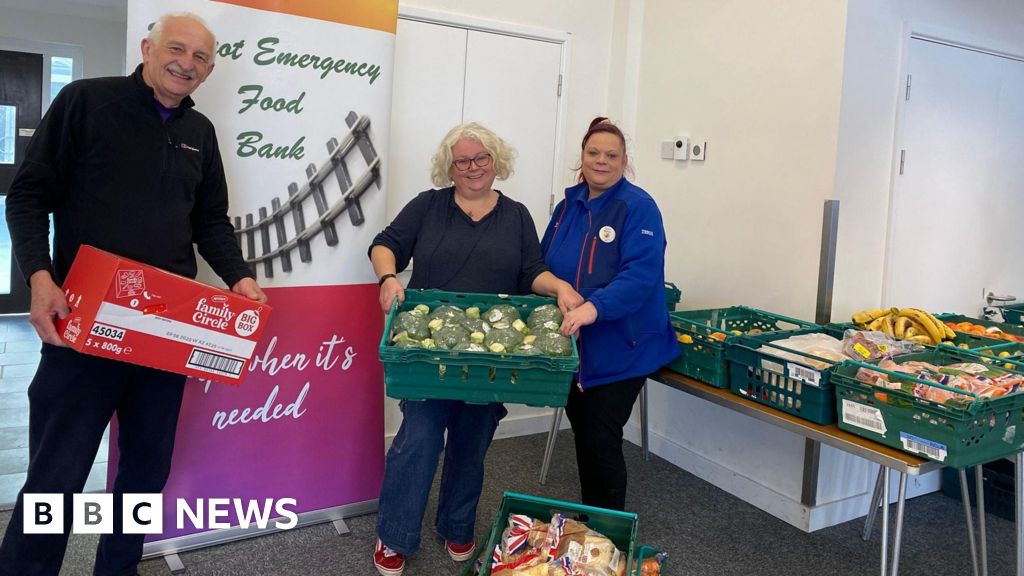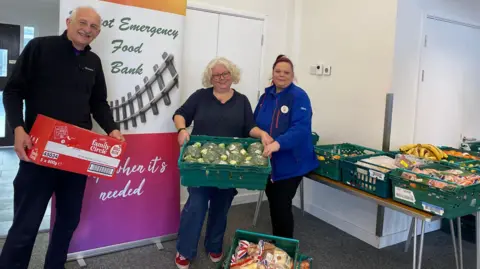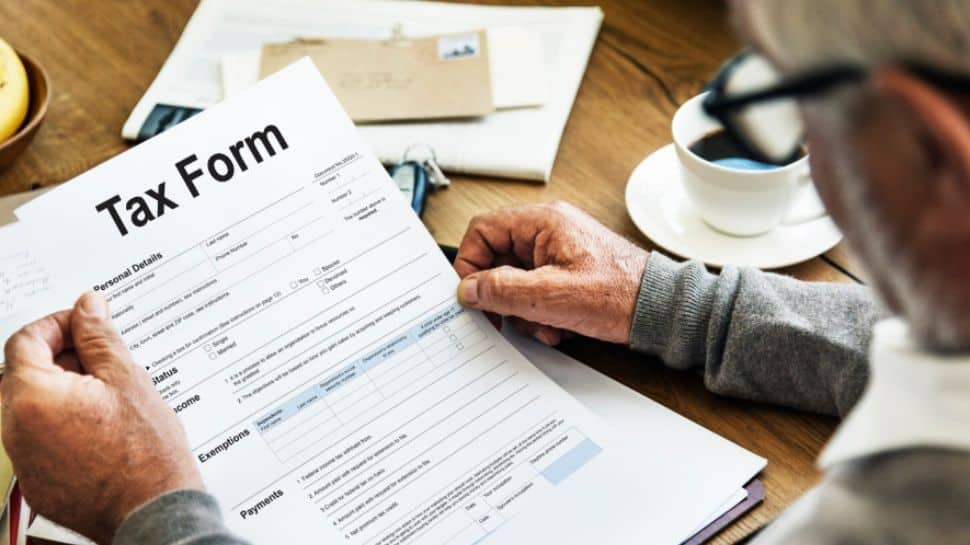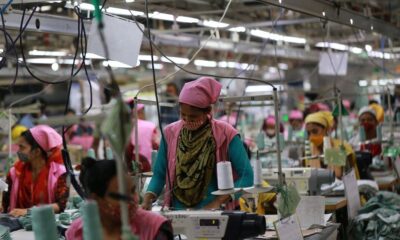Business
Funding shortage forces Didcot food bank to make changes

David GilyeatSouth of England
 Didcot Foodbank
Didcot FoodbankVolunteers at a food bank say they are having to make changes to the services they offer because of a reduction in donations.
Didcot Emergency Foodbank was launched in 2009 by volunteers at Didcot Baptist Church but is down to reserves of about £10,000.
Manager Andrew Snell said: “This year to date we will have had £29,000 income in cash, and we will have spent close to £60,000 on food, so there’s a big gap there.”
Previously the food bank provided support to its clients twice a week for six weeks, with a three-month gap before another referral. It is now changing this to once a week for six weeks, followed by a longer six-month gap.
“We’ve gone back to being what we were before covid, which is an emergency food bank, as opposed to helping families on low incomes who are just about coping, or not quite coping,” Mr Snell explained.
The food bank receives about 75% of its donations via cash, and 25% from physical food donations, though five years ago it was the other way around.
“People were giving us the actual food but not so much in the way of money,” Mr Snell said.
“People were so generous in Didcot and the surrounding villages, they gave us more than we would ever need [during covid] and that’s where the reserve came from.”
 Google
GoogleThe food bank still expects to support about 6,000 clients this year.
Mr Snell said: “It’s been absolutely great to be able to help families who are on the borderline, and obviously we’ll regret not being able to do that in the immediate future.
“We’ll be looking at things as we go along to see if we can relax what we’ve put in place but that’s a little way down the line. It’s a matter of regret.”
He added: “I hope we’ll be able to increase the donations and go back to full-on help for people who are going to get a bit squeezed out at the moment.”
South Oxfordshire District Council’s community hub, Citizens Advice, schools and nurseries, medical practices, health visitors, housing associations and certain charities can officially refer people in need to the food bank.
Business
Property Prices Have Surged 500% In These Religious Cities, NCR Realtors Enter The Market

Last Updated:
Bolstered by the popularity of Premanand Maharaj and the Banke Bihari Temple Corridor, Varanasi’s land prices have gone from Rs 20,000 per 900 sq ft to Rs 1 crore in just 4 years
Ayodhya land prices increased 50-100% due to Ram Temple construction.
In a striking shift from the traditional focus on metro and tier-1 cities, the real estate landscape is witnessing a new trend as pilgrimage and religious cities are becoming prime destinations for homebuyers and investors. Cities such as Ayodhya, Varanasi, Prayagraj, Vrindavan, and Haridwar are seeing a surge in property demand, with some areas experiencing price jumps of up to 500%.
Experts attribute this boom to a combination of religious tourism, major infrastructure projects, and increased economic activity in these cities. “The construction of the Ram Temple in Ayodhya, the Kashi Corridor in Varanasi, and major festivals like the Maha Kumbh have attracted a growing number of devotees,” said a property analyst. He said that the rise in footfall is directly influencing real estate, with demand for second homes, retirement properties, and serviced apartments at an all-time high.
Vrindavan: Prices Jump 500%
Vrindavan has emerged as one of the most expensive religious real estate markets in the country. The city’s growing prominence, bolstered by the popularity of Saint Premanand Maharaj and the Banke Bihari Temple Corridor, has seen land prices escalate from Rs 20,000 per 100 square yards to over Rs 1 crore in just four years in approved residential projects like Rukmini Vihar. Developers such as Omaxe, Basera, and Amaiya are actively launching high-rise residential and commercial projects, including Omaxe Krishna Crest, Omaxe Eternity, and Omaxe Bettgather Courtyard Mall, catering to the surge in demand.
Ayodhya: Land Prices Soar 50-100%
Ayodhya has witnessed a dramatic rise in property rates since the construction of the Ram Temple started. Land surrounding the temple has seen prices climb by 50-100%, prompting developers to plan theme-based townships and modern residential projects. Local developer Ayodhya Home & Soul Developers is reportedly preparing to launch a significant residential project in the city. Improved infrastructure and government-backed initiatives are further enhancing returns, making Ayodhya a hotspot for investors and homebuyers alike.
Prayagraj: From Industrial Hub to Real Estate Attraction
The Naini area in Prayagraj is rapidly transforming, driven by its emergence as both an industrial and educational hub. Developers, including Omaxe, are establishing large residential projects such as Omaxe Sangam City and Omaxe Ananda, shifting the market from traditional low-rise housing to high-rise developments.
Dehradun: Penthouses and Luxury Apartments in Demand
In Dehradun, Sahastradhara Road and Rajpur Road, along with areas near Tapkeshwar Mahadev and Drone Cave Temples, are witnessing growing real estate interest. Projects like Sikka Kimaya Greens and Excentia Tatva are introducing luxury apartments, high-rises, and penthouses, merging modern amenities with serene surroundings. Excentia Tatva, in particular, is being promoted as the city’s first uber-luxury residential experience.
Varanasi: A Rising Hub for Real Estate Investment
Varanasi continues to attract Shiva devotees and investors alike, with both residential and commercial properties seeing heightened interest. Improved connectivity and growing religious tourism are factors driving the city’s rising property prices.
Why Religious Cities Are Gaining Momentum
Several factors underpin this new trend:
- Religious tourism is seeing record growth, drawing lakhs of devotees annually.
- Enhanced highway, rail, and air connectivity makes these cities more accessible.
- Rising demand for retirement homes and second residences is fueling development.
- Branded developers from Delhi-NCR and other major cities are entering these markets.
- Government support and infrastructure projects are boosting investor confidence.
As spiritual hubs evolve into real estate hotspots, these cities are no longer just centres of faith, they are emerging as strong, high-return investment destinations.
November 18, 2025, 20:04 IST
Read More
Business
Govt To Notify New ITR Forms By January 2026, Implement Them From April

New Delhi: The Income Tax Department will notify new income‑tax return (ITR) forms and related rules under the streamlined Income Tax Act, 2025, by January, and the updated regulations be effective from April 1, 2026. The updated regulations will mark the transition from the nearly six-decade old Income Tax Act of 1961, multiple reports cited Central Board of Direct Taxes chairman Ravi Agrawal as saying.
Agrawal said the department is designing the new forms keeping it simple and easy to comply and adapt to. “We are in the process of designing the new forms and rules, and our aim is to notify them by January so that taxpayers have adequate time to adjust their systems and processes,” he was quoted as saying at the inauguration of Taxpayers’ Lounge at the India International Trade Fair (IITF) here.
Analysts said that the current framework of the rules is largely drafted in traditional legal language making it hard to understand and interpret. They said new rules should use simplified language, include illustrations for valuation rules, and align form structure with revamped TDS provisions under the new Income-tax Act 2025.
The Taxpayers’ Lounge offer a wide range of assistance and interactive resources that help with PAN/e‑PAN applications, Aadhaar–PAN linking and resolving PAN-related queries. Further, it will offer support for e‑filing, Form 26AS queries, TDS issues, guidance on international taxation, faceless assessment and appeals, and and other online filing issues.
Agrawal added that the Income Tax Department will release outstanding tax refunds by December. “We have analysed and found that some wrong refunds or deductions were being claimed so there is scrutiny, but we hope to release the remaining refunds by this month or December,” he added.
Business
Aviation upgrade: Aviation Minister K Rammohan Naidu says ATC systems under review; Delhi glitch probe to guide tech overhaul – The Times of India

Authorities are examining ways to strengthen air traffic control (ATC) systems after the technical snag at Delhi airport earlier this month disrupted operations and delayed more than 800 flights. Civil Aviation Minister K Rammohan Naidu said the incident has prompted a wider review of processes and technology at India’s busiest airport.Speaking on the sidelines of a conference on Tuesday, the minister noted that the investigation into the failure of the Automatic Message Switching System (AMSS), which supports ATC’s flight planning function, is still under way. “It will be known after a thorough investigation,” he said when asked if a cyber attack had been ruled out. He added that a detailed assessment has been initiated to identify the exact root cause.Naidu said the focus is now on enhancing the backbone of air navigation systems. “So, we are looking at how we have to improve our systems, meet the standards… (how to bring) future technologies into the ATC… we have asked them to let us know on what should be the way forward in terms of (whether they want) more upgraded technologies,” he said, according to PTI.The communication, navigation and surveillance (CNS) functions that support Air Navigation Services (ANS) and Air Traffic Management (ATM) are handled by the Airports Authority of India (AAI). Following the disruption on November 7, the minister had directed officials to conduct a root-cause analysis and put backup servers in place to reinforce operations.In a statement issued on November 8, the civil aviation ministry said the system had been restored by the afternoon owing to “the coordinated efforts of ECIL engineers, ATC personnel, and the ministry’s proactive monitoring”. It added that no flights were cancelled that day due to the issue.The Indira Gandhi International Airport (IGIA), which has four runways and manages over 1,500 daily flight movements, continues to operate normally as the probe into the November 7 disruption progresses.
-

 Tech1 week ago
Tech1 week agoFrom waste to asset: Turning ethanol production CO₂ into jet fuel
-

 Tech3 days ago
Tech3 days agoNew carbon capture method uses water and pressure to remove CO₂ from emissions at half current costs
-

 Politics5 days ago
Politics5 days agoBritish-Pakistani honoured for transforming UK halal meat industry
-

 Sports3 days ago
Sports3 days agoTexas A&M officer scolds South Carolina wide receiver after touchdown; department speaks out
-

 Business3 days ago
Business3 days agoThese 9 Common Money Mistakes Are Eating Your Income
-

 Tech1 week ago
Tech1 week agoSecurity flaws in portable genetic sequencers risk leaking private DNA data
-

 Tech4 days ago
Tech4 days ago$25 Off Exclusive Blue Apron Coupon for November 2025
-

 Fashion1 week ago
Fashion1 week agoBangladesh garment makers eye $5 bn more in exports post policy tweak





